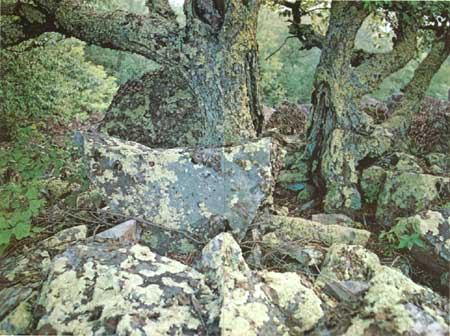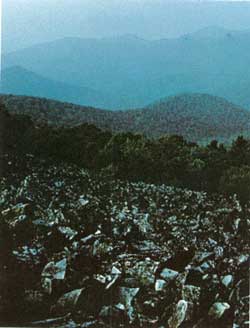|
SHENANDOAH National Park |
 |
Life on the Rocks
Probably no Shenandoah environment is more hostile than its cliffs and the rock slides below them, which are scattered throughout the park. From its nest on a sheltered cliff ledge, the raven looks down upon a place that is at the mercy of the sun, heating rapidly by day and cooling rapidly at night. Whatever moisture falls on these jumbles of boulders, except that held in crevices or under the rocks, is evaporated by the sun or runs off down the steep slopes.
Yet even here there is life. Clinging to the face of the in hospitable rock, lichens exhibit a remarkable partnership in living. The main body of the lichen consists of a fungus, which provides anchorage to the rock and absorbs water, air, and mineral nutrients. The lifegiving partner is a green alga, whose cells are imbedded in the fungus. Using energy from the sun, its chloroplasts manufacture food for both of them from the substances absorbed by the fungus. Following closely in ability to make something from virtually nothing are mosses, which on level or shaded parts of the rocks can obtain enough water to survive. These pioneers gradually trap dust and their own decay, until enough sustenance has accumulated to support ferns and small flowering plants such as stonecrop and saxifrage. Cracks in the rocks, acting as soil collectors, eventually sprout small green plants. Even some trees grow on a rock slide The black birch is adept at colonizing such places, sending down long roots to find moisture and nutrients in the scant soil.
 Lichens, which encrust rocks and tree trunks in Shenandoah, can tolerate almost any conditions except polluted air. (Photo by Ross Chapple) |
Animal life, directly or indirectly dependent on plants for food energy, must wait for them or their debris to occupy the rocks before moving in. Open rock slides where lichens are the only visible plants seem to be barren of animal life, but upon closer search you may find a small, pale-gray spider, whose color matches that of the rock. Where there are spiders—which are predators—there must be prey, I thought. But so far I have found only a few ants and flies that might serve as spider food in such situations; there must be other insects down under the rocks, taking advantage of small plants and litter.
Interestingly, the spiders on the dark, lichen-encrusted boulders at Blackrock, in the south section, are black. These may be either a different species or the same as those on light-colored rocks; for some spiders, like chameleons, can change color. In both cases, the rock-matching color camouflages the spiders from prey and predators.
Where the rocks lie on easier slopes, soil washed down from above can gradually collect between them. Here tiny gardens of moss, ferns, and other small plants develop, and with them a richer community of animal life. There are more insects and other in vertebrates, and mice and wood-rats may appear. One of the most interesting inhabitants of such vegetation islands in rock slides is the Shenandoah salamander, whose total known population is confined to the upper north sides of Hawksbill, Stony Man and The Pinnacles. Herpetologist Robert Jaeger, who studied this salamander intensively, found that it inhabits chiefly the edges of rock slides, where soil and litter have accumulated between the rocks, and that a close relative, the red-backed salamander, takes over beyond the edge, where soil completely covers the rocks. This situation, Jaeger believes, represents the last stage in the history of the Shenandoah salamander as a taxonomic entity. Once, he thinks, the Shenandoah salamander occupied much of the Blue Ridge, but then for some reason the widespread red-backed salamander began extending its range into the mountains. By superior ability to compete for food the redback forced the former into the few pockets of talus it now inhabits. The redback, not as well adapted to dryness, cannot occupy the slide. Because of the competitive disadvantage, as soil gradually covers the rock, the Shenandoah salamander will probably become extinct.
 The forest is advancing slowly on this Shenandoah rockslide. (Photo by Ross Chapple) |
The dwindling fortunes of the Shenandoah salamander again illustrate the dynamic character of nature, where change is the rule. A longer-term process than the covering of rock slides with soil and the disappearance of their salamanders is the actual breakdown of rock into soil. The soil on which land life depends is composed mostly of tiny rock particles, the end result of thousands of years of freezing, thawing, wind and water erosion, and even the prying action of growing roots, all of which reduce large rocks to smaller and smaller pieces. To these inorganic particles are added decaying plants and animals, upon which millions of small organisms feed. The soil is thus an amalgam of living and non-living things, with rock particles providing some of the mineral nutrients for plants growing from the soil. The next time you see a great, "ageless" boulder lying in the forest, think of this: it will be home and sustenance for some far-future life.
In this part of the world, forest is usually the last step in the plant-and-animal succession that begins with rock colonization and soil formation. In Shenandoah we can see various stages in this progression, since man with his cutting, burning and livestock grazing has set back the successional clock. Rock, meadow, brush, pioneer forest, and mature forest—each has its distinctive plants and animals, which fade and are replaced as each stage gives way to the next.
The drama of each community and its passing is a tragicomedy that can spellbind. Part of its grip on a discerning audience no doubt lies in the knowledge that we too are involved. For we are as inextricably tied to our environment, world-wide though it may be, as any spider on a rock. And if our environment becomes unfit for us, we will, as surely as the Shenandoah salamander on its shrinking rock slide, face extinction.

|

|
| NPS History | History & Culture | National Park Service | Contact |
|
Last Modified: Sat, Nov 4 2006 10:00:00 pm PST |


